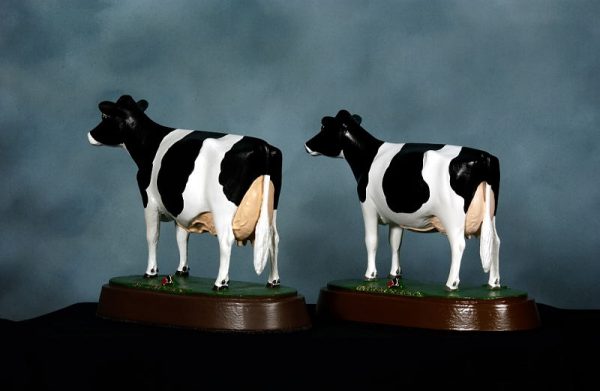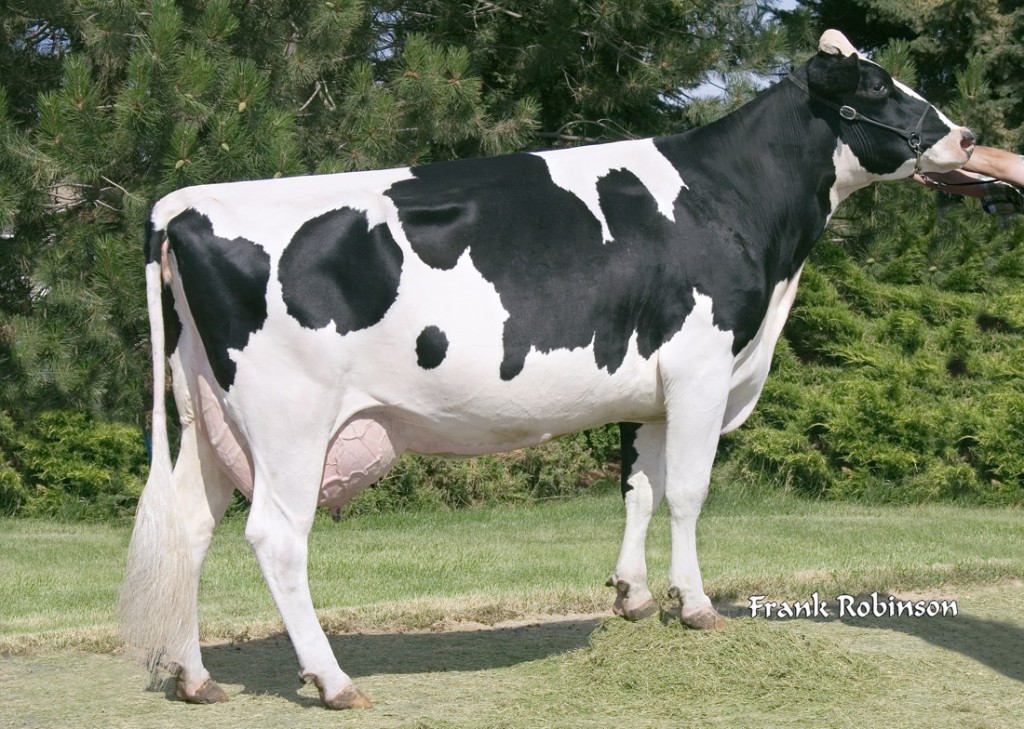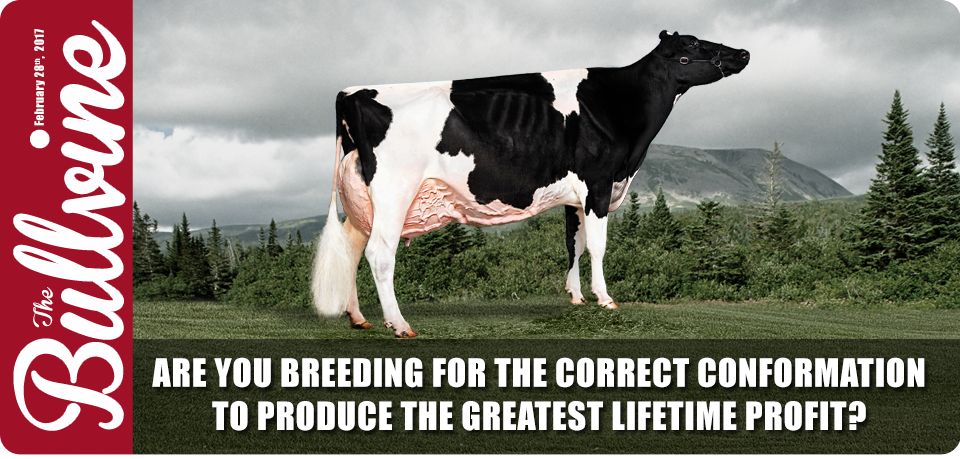Are show ring standards for type relevant in most dairies? The Bullvine looks to the future and the question in 2017 is expanded to: “Are show ring standards providing relevant prototypes for the ideal conformation for the cow of the future in most dairy operations?” The Bullvine has written on this topic on numerous occasions in order to stimulate breeders to think, discuss and help influence adoption of the most scientifically correct conformation standards for their dairy operation. (Read more: What’s Needed in Type Beyond Udders, Feet, and Legs? and She Ain’t Pretty – She Just Milks That Way!) For forward-looking Bullvine readers here is some additional food for thought.
Classifier Looks to the Future
Recently the Bullvine asked Tom Byers for his thoughts on the type of cow for the future. Tom is currently a consultant to Holstein Canada. He was previously its head classifier and was instrumental in bringing type classification for all Canadian dairy breeds under one program. (Read more: TOM BYERS: “THAT’S CLASSIFIED!”) The Bullvine found his thoughts interesting on the conformation of young cows. Remember that the classification data for first calf females is the basis for conformation bull proofs and cow indexes in most countries.
Tom shared the following pictures of models developed a decade ago.

Young First Calf Heifer Model

True Type Mature Cow & Heifer Models
Tom commented of the young cow model as follows:
- The young cow model is not a true type but rather a model of the young cow that Holstein Canada believes has the correct conformation to grow into the mature true type model cow
- This young cow is 22-24 months of age and 30-60 days in milk
- She is lower in her front end than in her rump
- She has correct body depth for her age and stage of lactation
- Her rump angle is sloped from hips to pins
- Her loin is very strong
- She has depth of heel and a symmetrical shape of foot
- Her udder is very well attached both fore and rear with a high rear attachment
- As she ages, calves for future lactations and matures, she will be “the cow for the future”
Let’s Reflect on Byer’s Comments and the Young Cow
Some points that Tom did not mention but that are obvious on the young cow model include:
- She has enough volume of udder, length, width and depth, to carry a large volume of milk
- She will walk straight on both fore and rear legs
- Her thurls are placed mid-point so she can walk properly
- Carries very good body condition
- If she is 54-56” at the rump (135-140 cm) at 22-24 months, she will be 58-60” (145-150 cm) at maturity
- She is long from the tip of her nose to the tip of her tail
It appears to The Bullvine that these black and white models could be painted red & white, all brown, all fawn, all black and even all brindle and they could be the model for any dairy breed. Functional correctness and longevity are desired for all breeds and for crossbreeds as well.
Breeders Look to the Future
As 99% of the cows and 99.9% of the milk produced in the future will come from profit focused production herds, let’s listen to what leading spokespersons for commercial breeders say about what they want their cows’ conformation to be:
SeaGull Bay Dairy (Idaho): In conversation with Alan Andersen, he reported that “My ideal two-year-old would probably score not more than 80-82 points because she isn’t tall enough or sharp enough to satisfy the present program. They are the ones that work hard for us and stay around for profitable lifetimes.” (Read: Charting The Course at SeaGull Bay Dairy)
North Florida Holsteins (Florida): Don Bennink states (Read: North Florida Holsteins – Aggressive, Progressive and Profitable) “Particularly in the current genomic era and with the advancements to come in knowing more about the DNA makeup of our dairy cows, breeding for conformation is putting the cart before the horse. Example: The cow with the best rump is the cow with the best calving ease (MCE), the highest fertility (DCR, CCR, HCR), the most mobility and with plenty of room for a capacious udder (length & width). We need to breed directly for the characteristics commercial breeders need rather than breeding a rump that we “think” might get us there.”
Rosy-Lane Holsteins (Wisconsin): Lloyd Holterman states that they have ceased classifying their cows. (Read: Rosy-Lane Holsteins “Don’t Follow the Herd!”) For Lloyd tall, pretty and infertile does not cut it for them any more as an essential part of their farm’s mission statement is “maintain an economically viable business unit with future potential.” Using the type classification program was not helping their farm achieve that mission. Lloyd ‘s states that their ideal cow is “A cow that calves like an Oman, has the disposition like a Shottle, breeds back like a Freddie, has high lifetime like a Ramos, has high fat and protein per lactation like a Supersire and has an immune system like an Uno. This type of cow shows that desirable genes come from around the world.”
Breeders that follow their friends on Facebook will know that Cliff Shearer (New Zealand) and Eric Silva (Oregon) routinely picture Jerseys that yield large volumes of milk solids and are able to do it entirely from grass or in a modern large herd environment. Both Cliff and Eric show their preference for functional trouble free cows that do not need to have the style, stature and blending of parts of the show winning cows.
Sire Selection Is Important
Holstein USA recently released information on sires with the most recently registered progeny – “Robust’s legacy dominates the top registrations in the USA”. In fact, six of the current top ten sires with the most newly registered Holsteins were Robust sons or grandsons. (Read more: ROBUST’S LEGACY DOMINATES THE TOP REGISTRATIONS IN THE USA) Table 1 is the profile for Robust daughters at 99% REL.
Table 1 Roylane Socra Robust 7HO10254 (Socrates x Oman x Manat x Celsius x Melwood x Secret x Mars Tony)
So today’s US Holstein breeders are aware of and are breeding for the conformation they want their herds to have in the future. Breeders are breeding for productive, healthy and long-lived cows without the need for them to be tall, large, deep rear ribbed, stylish and smoothly blended.
An interesting note is that the Andersen’s of Seagull Bay bred both Robust’s dam, SeaGull-Bay Oman Mirror, and Robust’s top son, SeaGull-Bay Supersire (Robust x Plant x Shottle x Oman x Rudy Missy) #1 NM$ and #2 TPI for proven US Holstein sires. Supersire leads with the largest number of recently registered progeny in the USA.
The Preferred Cow
Don Bennink says it this way “The preferred cow for the most profitable dairymen is the cow that gives the most milk, the most protein and the most fat per unit of body weight with the desired health traits. Negatives are too much size and cattle that are sharp and angular. Thin cattle result in: low fertility; more animals that don’t show heats; higher somatic cells counts; less disease resistance; and poor foot health”.
In Alan Andersen’s words “Our goal is to breed elite sires and females that will benefit other breeders and commercial dairymen as well as ourselves. We like cows that excel in production of milk components (pounds of protein and fat), have quality mammary systems and are low maintenance.”.
Evaluation Standards
It incumbent upon all type classification programs when setting standards and guidelines to remember Don Bennink’s statement “We believe that the function of a seed stock producer is to produce the animal that is the most profitable for the commercial dairyman.”
For The Bullvine the young cow model shared with us by Tom Byers goes a long way toward satisfying the cow conformation needs of commercial dairy people. After thirty-fours of evaluating the conformation of dairy cows, Byers recommends some changes: 1) calling the program Conformation Assessment; 2) discontinue assigning a final class to animals – assign only an overall point score; 3) Conformation Assessment need to first a breed improvement rather than a marketing tool; and 4) when assigning point scores to body parts consider age, stage of lactation and lactation number. For example, an 88 point Mammary would visually appear much different on a young fresh, 23-month-old, first calver compared to a mid-lactation sixth calving eight-year-old cow.
Allan Andersen shared his thoughts on the young cow model – “I quite like the model of the young Holstein cow. I would say that for me the height of rear udder is a little more extreme than necessary for functionality and less height of rear udder would probably match the shorter animal better.”
Lloyd Holterman looks at this way – “The industry needs to continue to focus on the development of the most profitable cow. The Canadian young cow model is interesting for me. In my view, it is way more practical than any of the previous models that I have seen. The first thing that I noticed is that she has more body conditioning – those cows stand up and produce better in hot weather and bounce back quicker after an illness. The comment about foot angle perhaps needs further study and thought. Average foot angle with slightly spread toes is where research is headed. This was certainly a shock to me when I first heard it. And it was tough to embrace as no one wants to breed average for any trait even if it is what is optimal. Another place to optimize is size. Rosy-Lane’s target is 58 inches at the hip for mature cows with a range of 56-60 inches.”
Pictures of SeaGull-Bay Oman Mirror and the Holstein USA Ideal Cow appear below. In The Bullvine’s opinion there all many similarities amongst the pictures of Mirror, the Ideal US Holstein Cow, and the Canadian Young Cow except for the moderate height of Mirror’s rear udder attachment. Definitely, as conformation is assessed in the future, it should be a matter of Form Following Function, instead of Function Following Form.

Seagull-Bay Oman Mirror VG-86 DOM Dam of Roylane Socra Robust

Holstein USA Ideal Cow (Painted by Bonnie Mohr)
The Bullvine Bottom Line
Breeders can expect to have genetic indexes for many new and economically important traits over the next few years. The information for these indexes will come from both farm data and DNA profiles. Some of these indexes will provide a greater knowledge of the correct cow conformation to compliment high lifetime profit. It is time to leave the past perceptions about the correct conformation for cows behind and adopt the new. The downside for breeders that stick with the past ideals for conformation is that they will be faced with their herds becoming museums that do not generate adequate breeding stock or milk revenue to remain viable.
Get original “Bullvine” content sent straight to your email inbox for free.
[related-posts-thumbnails]



















Leave a Reply
You must be logged in to post a comment.